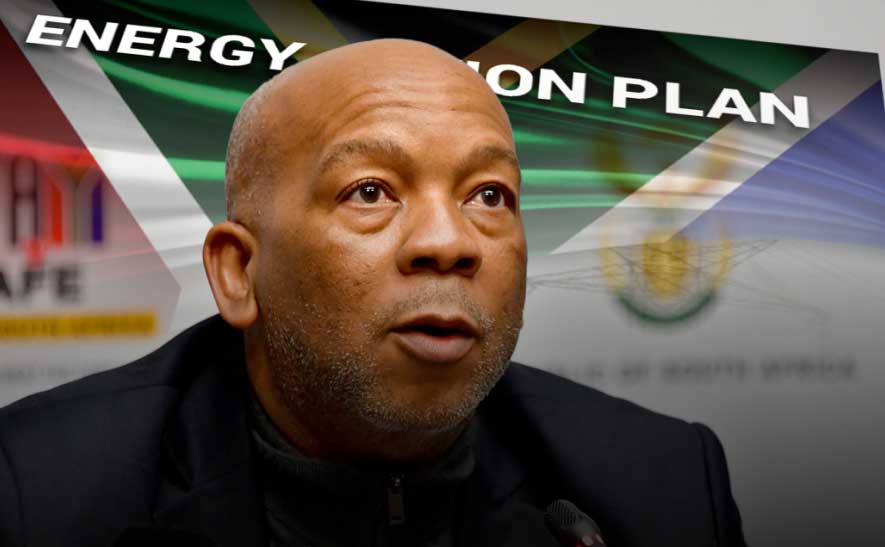The Energy
Action Plan
The EAP is a set of steps to fix our energy problems and end loadshedding as quickly as possible. It will increase our electricity supply, lower our energy costs and help us switch to renewable energy sources. Government is working with businesses and other groups to make this happen. The end goal is to ensure we have enough energy to power our homes and businesses now and for the future.
Ministerial updates
The Minister for Electricity, Dr. Kgosientso Ramakgopa, keeps South Africans informed with regular updates on the ongoing efforts to resolve the electricity crisis, ensure energy security and end load shedding.

Ministerial Energy Action Plan briefing - 23 October 2023
DownloadGeneration performance 26 September to 29 September 2023
DownloadGeneration performance 18 September to 22 September 2023
DownloadGeneration performance 01 September to 10 September 2023
DownloadGeneration performance 28 August to 02 September 2023
DownloadGeneration performance 14 August to 18 August 2023
DownloadGeneration performance 07 August to 11 August 2023
DownloadGeneration performance 31 July to 04 August 2023
DownloadThe five-step plan has set timeframes and actions to address the electricity shortfall:
Maximise the output of Eskom's power stations
Fix Eskom and improve existing supply
- Eskom is fixing the six power stations that cause the most load shedding. They are also building a solution to bring back units at Kusile and Medupi power stations, which together cause more than three stages of load shedding. Government has provided debt relief to Eskom so that it can buy diesel, invest in maintenance and expand the transmission network to reduce the amount of load shedding.
- Improved plant performance has already brought down the number of breakdowns this year, with a target of increasing available capacity by 3 000 MW planned by next year.
- Eskom has also introduced the Distribution Demand Management Programme (DDMP) which will pay qualifying businesses to reduce their power usage by investing in energy efficiency technologies or shifting their operations to off-peak times. Read more at www.eskom.co.za/distribution/demand-management-programme.
Add as much new generation capacity as possible
Buy as much new power as possible, as quickly as possible to close the electricity shortfall
- An additional 400 MW has been imported from Cahora Bassa in Mozambique, with plans to import additional power from neighbouring countries.
- Government has approved the procurement of new wind, solar, and battery storage projects that will generate over 14 000 MW from independent power producers.
Unleash businesses and households to invest in rooftop solar
- Government has introduced special tax incentives for businesses and households who install solar and a revised bounce-back loan scheme to help small businesses go solar. As an added benefit, you can also now sell any surplus power you generate back to the grid in certain areas.
Enable private investment in generation
- Schedule 2 of the Electricity Regulation Act has been amended to make it possible for the private sector to invest in much larger energy projects without any limitation on size. This has unlocked a massive pipeline of new energy projects across the country which are currently in development or construction.
- Eskom will buy power from companies that have it to sell, for three years through the Standard Offer Programme. They'll also buy extra power when the grid is under strain through an Emergency Generation Programme. Click here to read more about these programmes.
- Approval processes for new energy projects are being fast-tracked:
- Transmission infrastructure no longer needs an environmental permit in areas with low environmental impact.
- Environmental permits are now issued in 57 days for Strategic Infrastructure Projects.
- Registration with NERSA now takes an average of 19 days.
- Grid connection now takes six months instead of nine.
- Land-use authorisations now take 30 days instead of 90.
- Eskom has prioritised 25 transformation projects for the transmission network, which will add 12 GW capacity to the grid by 2028. A dedicated workstream has been created in NECOM to strengthen and expand transmission infrastructure so that we can connect all the new energy that we need.
Transform the electricity sector
- The National Transmission Company of South Africa is being set up as an independent entity responsible for managing the national electricity grid. This will keep the national grid in state hands, but create a level playing field to allow for more private sector participation.
- New legislation has been tabled in Parliament to create a competitive market for electricity – the Electricity Regulation Amendment Bill. In the future, this will allow consumers to choose which energy supplier they want to buy power from, and enable competition and efficiency from multiple electricity generators.
These changes will radically transform the structure of the electricity sector for future generations.
